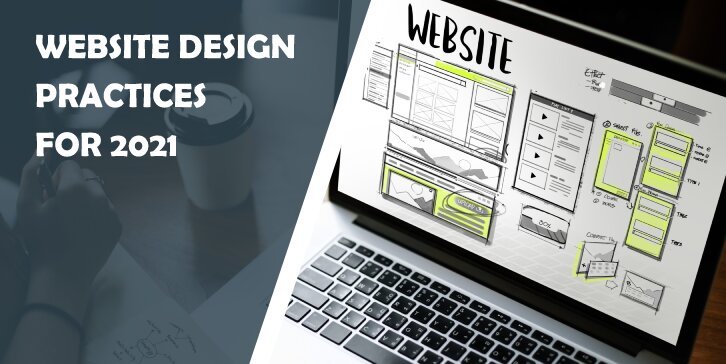Setting up a website is pretty accessible these days, but optimising your web design, now that’s another story.
Good design is deceptively simple. A well-designed website often looks and functions so well that you hardly notice the design choices. But jump onto a poorly designed website, and you can really notice the flaws.
Whether you’re setting up a website for the first time or have been in the game for a while, design really matters. It affects your conversion rates, your credibility, and your customer loyalty.
At its core, web design is about improving user experience – how someone feels when they interact with your website. Are you leaving them with a positive experience that will bring them back again?
The good news is web design doesn’t have to be a guessing game. There are a number of web design principles that have been proven to get good results. We’re going to share with you 8 of the most important.
They are:
- Break up text
- Show, don’t tell
- Lead your users
- Consider your colours
- Embrace white space
- Aim for familiarity
- Make it mobile-friendly
- Speed things up
1. Break up text
You’ve got to have text on your website, but the way you go about it can put people off or encourage them to stick around.
There’s nothing that says “don’t read me” like a big block of text.
If you don’t have to say something, don’t. Keep your text to a minimum where appropriate, use shorter paragraphs and break up your content with headings. Try out lists and dot points.
The key is to create scannable content so that your visitors can find what they need, fast.
2. Show, don’t tell

It’s an old cliche, but it still stands. Visual content is much quicker for your website users to absorb than text.
So if you can explain something with an infographic or communicate a message with a photograph – do it.
Think of the visual content and the text working hand in hand. How can you use them both to say things faster and more effectively?
3. Lead your users
Ever heard of choice fatigue? The more choices your website visitors have to make, the less likely they are to stick around.
Instead, you want to make it a breeze for them. Take them by the hand, so to speak, and lead them exactly where you want them to go.
This means reducing the number of items on your menu. It means sticking to standard formats like having your logo in the top left and your menu in the top right.
Don’t go over the top with navigation. Simple and intuitive is best.
4. Consider your colours

It might seem a little basic, but your colour choices can make a big difference to how people perceive your website and your brand.
Yes, your brand. The colours on your website should be consistent with your branding across other platforms. You should choose a colour scheme that reinforces your brand image.
First up, keep it simple. Choose 2-4 on-brand colours and stick with these throughout your entire website.
Secondly, be consistent. Use the same colour for all your CTA buttons, make all your headings one colour, etc.
5. Embrace white space
What are the stars without the black sky as a backdrop? The negative space you leave around your content is massively important.
Don’t overcrowd your website. Leave enough room around each element so that it can breathe. This will make it much easier for users to read and engage with your content.
And while you’re spacing things out, make sure your spacing is consistent. This will help users differentiate between different sections or blocks on your webpage.
6. Aim for familiarity

If you want users to feel at ease on your website, you’ve got to eliminate confusion. One of the best ways to do this is by making things feel familiar.
Whether the user is on your homepage or your about page, they should feel like they’re on the same website. Your branding and messaging should be consistent, but so should things like your call to action and your choice of words.
Consistency is the key to a better user experience and a more solid brand identity. It leaves visitors with a clear and lasting impression of your brand.
7. Make it mobile-friendly
How often do you browse websites on your phone or iPad? If you’re anything like the rest of us, you do it a lot. In fact, some say mobile usage has now surpassed desktop usage.
So what does that mean for your website? It means you’d better optimise for mobile or risk alienating all those mobile users. Ensure your web design looks great and functions well on mobile devices as well as a desktop.
Mobile optimisation is actually a key factor for your search engine rankings too – Google prefers websites that are mobile-friendly.
8. Speed things up

Your design choices can have a huge impact on the load speed of your website. And we know how important it is to have a fast website. People don’t like to wait – you’ve got about 3 seconds to get their attention.
Here are a few ways you can speed things up with design:
- Optimise your images and reduce their file size
- Use browser caching plugins and tools
- Reduce HTTP requests
- Minify your files
Did you know that the speed of your website can affect your Google rankings too?
Good web design is a work in progress
Whether you’re just starting out or have had your website for a while, website design really matters. But it’s not a set-and-forget kind of thing. It’s often an ongoing process of making small improvements.
Being faced with a list of design must-do’s can be overwhelming, but try and see it as a place to start. A checklist that you can work through, making slow and steady progress.
Putting website design principles into practice (even if it’s one at a time) will help you improve user experience, engage with your audience better and maintain a competitive edge.
Keep reading the article at WP Pluginsify. The article was originally written by Editorial Staff on 2021-04-01 08:28:30.
The article was hand-picked and curated for you by the Editorial Team of WP Archives.

